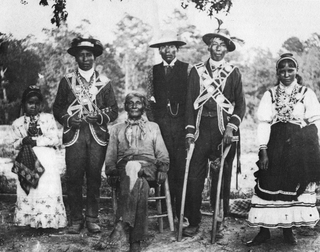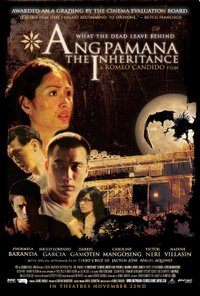
Choctaw mythology is part of the culture of the Choctaw, a Native American tribe originally occupying a large territory in the present-day Southeastern United States: much of the states of Mississippi, Alabama, and Louisiana. In the 19th century, the Choctaw were known to European Americans as one of the "Five Civilized Tribes" even though controversy surrounds their removal.

In the indigenous religion of the ancient Tagalogs, Bathalà/Maykapál was the transcendent Supreme God, the originator and ruler of the universe. He is commonly known and referred to in the modern era as Bathalà, a term or title which, in earlier times, also applied to lesser beings such as personal tutelary spirits, omen birds, comets, and other heavenly bodies which the early Tagalog people believed predicted events. It was after the arrival of the Spanish missionaries in the Philippines in the 16th century that Bathalà /Maykapál came to be identified with the Christian God, hence its synonymy with Diyós. Over the course of the 19th century, the term Bathala was totally replaced by Panginoón (Lord) and Diyós (God). It was no longer used until it was popularized again by Filipinos who learned from chronicles that the Tagalogs' indigenous God was called Bathalà.

Little people have been part of the folklore of many cultures in human history, including Ireland, Greece, the Philippines, the Hawaiian Islands, New Zealand, Flores Island, Indonesia, and Native Americans.

Spiral is a 1998 Japanese supernatural horror world cinema film. It is a sequel to the 1998 film Ring. It is directed by Jōji Iida and is based on the novel of the same title by Koji Suzuki. It is titled The Spiral in English on the Japanese poster and video packaging, and it was previously released in North America as Rasen and in the United Kingdom, Ireland, and the Philippines as The Spiral.

An ant colony is a population of a single ant species able to maintain its complete lifecycle. Ant colonies are eusocial, communal, and efficiently organized and are very much like those found in other social Hymenoptera, though the various groups of these developed sociality independently through convergent evolution. The typical colony consists of one or more egg-laying queens, numerous sterile females and, seasonally, many winged sexual males and females. In order to establish new colonies, ants undertake flights that occur at species-characteristic times of the day. Swarms of the winged sexuals depart the nest in search of other nests. The males die shortly thereafter, along with most of the females. A small percentage of the females survive to initiate new nests.

Indigenous Philippine folk religions are the distinct native religions of various ethnic groups in the Philippines, where most follow belief systems in line with animism. Generally, these Indigenous folk religions are referred to as Anito or Anitism or the more modern and less ethnocentric Dayawism, where a set of local worship traditions are devoted to the anito or diwata, terms which translate to gods, spirits, and ancestors. 0.23% of the population of the Philippines are affiliated with the Indigenous Philippine folk religions according to the 2020 national census, an increase from the previous 0.19% from the 2010 census.
Gabà or gabaa, for the people in many parts of the Philippines particularly among Visayans, is the concept of a non-human and non-divine, imminent retribution. A sort of negative karma, it is generally seen as an evil effect on a person because of their wrongdoings or transgressions. The word has later been recycled for translating "divine retribution" or "divine fury" in the translations of the Bible to many local languages in the Philippines. It is also translated as nemesis. The opposite of gaba is grasya, literally grace in Spanish, which pertains to blessings from Heaven. The English word which is closest to or best describes the word gabà is comeuppance.
Pedro Penduko is a Filipino fictional comic book character created by National Artist for Literature Francisco V. Coching. The character, who is styled as a folk hero, debuted in the magazine Liwayway in 1954.

Ang Pamana: The Inheritance is a 2006 Filipino supernatural thriller film.

Da Adventures of Pedro Penduko is the third and fourth season of the Philippine fantasy TV series Komiks. The third season began airing in the Philippines on September 9, 2006, and ended on April 28, 2007, on the ABS-CBN.

A duende is a humanoid figure of folklore, with variations from Iberian, Ibero American, and Latin American cultures, comparable to dwarves, gnomes, or leprechauns. In Spanish duende originated as a contraction of the phrase dueñ(o) de casa, effectively "master of the house", or perhaps derived from some similar mythical being of the Visigoth or Swabian culture given its comparable looks with the “Tomte” of the Swedish language conceptualized as a mischievous spirit inhabiting a dwelling.
Mythic humanoids are legendary, folkloric, or mythological creatures that are part human, or that resemble humans through appearance or character. Each culture has different mythical creatures that come from many different origins, and many of these creatures are humanoids. They are often able to talk and in many stories they guide the hero on their journey.

Souls in Filipino cultures abound and differ per ethnic group in the Philippines. The concept of souls include both the souls of the living and the souls or ghosts of the dead. The concepts of souls in the Philippines is a notable traditional understanding that traces its origin from the sacred indigenous Philippine folk religions.
Religions in pre-colonial Philippines included a variety of faiths, of which the dominant faiths were polytheist indigenous religions practiced by the more than one hundred distinct ethnic groups in the archipelago. Buddhism, Hinduism, and Islam were also present in some parts of the islands. Many of the traditions and belief systems from pre-colonial Filipino religions continue to be practiced today through the Indigenous Philippine folk religions, Folk Catholicism, Folk Hinduism, among others.

Anito, also spelled anitu, refers to ancestor spirits, nature spirits, and deities in the Indigenous Philippine folk religions from the precolonial age to the present, although the term itself may have other meanings and associations depending on the Filipino ethnic group. It can also refer to carved humanoid figures, the taotao, made of wood, stone, or ivory, that represent these spirits. Anito is also sometimes known as diwata in certain ethnic groups.
In the Philippines, a handful of superstitious beliefs exist that are very famous amongst the natives. These beliefs are typically introduced to them at a very early age through children's books or bedtime stories. It is believed that if natives aren't careful to follow them, a curse will befall them.











